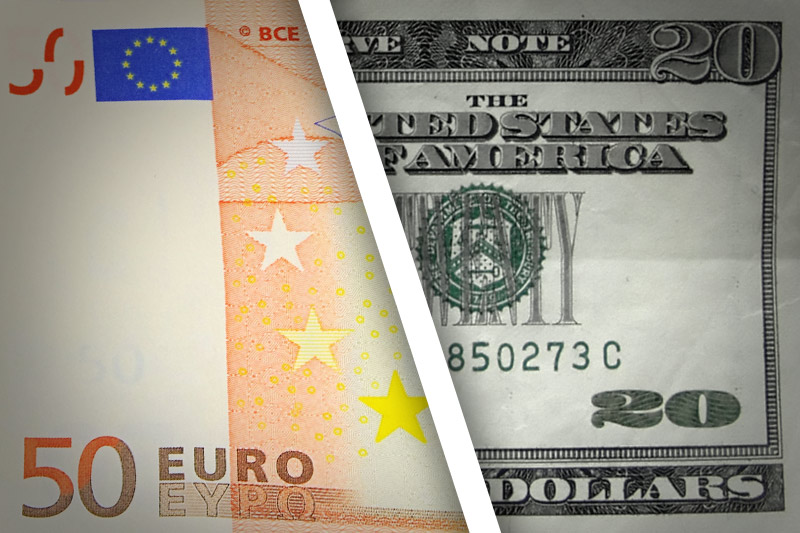Investing.com - Weaker-than-expected Italian industrial output data sent the euro falling against the dollar on Friday.
The liquid greenback also served as a safe-haven for investors tracking events at a G7 meeting of finance ministers and central bankers.
In U.S. trading on Friday, EUR/USD was down 0.75% at 1.2945, up from a session low of 1.2936 and off from a high of 1.3051.
The pair was likely to find support at 1.2936, the earlier low, and resistance at 1.3194, Wednesday's high.
The euro softened after Italy reported that industrial output dropped 0.8% in March after contracting 0.9% in February.
Analysts were expecting a 0.2% contraction in output at the country's factories, mines and utilities.
Elsewhere on Friday, official data revealed that Germany's trade surplus narrowed less than expected in March, falling to EUR17.6 from a surplus of EUR17.7 billion the previous month.
Analysts were expecting the trade surplus to narrow to EUR16.5 billion in March.
The dollar, meanwhile, saw support as a meeting of G7 finance ministers kicked off, with investors eagerly awaiting hints as to when monetary stimulus programs may unwind and when fiscal reforms may take place.
The dollar also enjoyed residual support stemming from Thursday's weekly data on jobless claims.
The Department of Labor reported Thursday that the number of individuals filing for initial jobless claims in the U.S. last week fell by 4,000 to 323,000, defying expectations for an increase of 8,000 to 335,000.
The news sparked demand for the dollar by fueling sentiments the Fed may closer to dismantling dollar-weakening stimulus programs, including its monthly USD85 billion bond-buying program.
Last week, the Bureau of Labor Statistics reported that U.S. economy added 165,000 nonfarm payrolls in April, up from 138,000 in March, whose figure was revised up from 88,000.
April's figures far outpaced analysts' forecasts for a 145,000 figure.
The euro, meanwhile, was up against the pound and up against the yen, with EUR/GBP trading up 0.09% at 0.8450, and EUR/JPY trading up 0.42% at 131.79.
In the U.K. earlier, official data revealed the trade deficit narrowed less than expected in March, coming in at GBP9.1 billion from a of GBP9.2 billion deficit the previous month.
Analysts were expecting the trade deficit to narrow to GBP9.0 billion in March.
The liquid greenback also served as a safe-haven for investors tracking events at a G7 meeting of finance ministers and central bankers.
In U.S. trading on Friday, EUR/USD was down 0.75% at 1.2945, up from a session low of 1.2936 and off from a high of 1.3051.
The pair was likely to find support at 1.2936, the earlier low, and resistance at 1.3194, Wednesday's high.
The euro softened after Italy reported that industrial output dropped 0.8% in March after contracting 0.9% in February.
Analysts were expecting a 0.2% contraction in output at the country's factories, mines and utilities.
Elsewhere on Friday, official data revealed that Germany's trade surplus narrowed less than expected in March, falling to EUR17.6 from a surplus of EUR17.7 billion the previous month.
Analysts were expecting the trade surplus to narrow to EUR16.5 billion in March.
The dollar, meanwhile, saw support as a meeting of G7 finance ministers kicked off, with investors eagerly awaiting hints as to when monetary stimulus programs may unwind and when fiscal reforms may take place.
The dollar also enjoyed residual support stemming from Thursday's weekly data on jobless claims.
The Department of Labor reported Thursday that the number of individuals filing for initial jobless claims in the U.S. last week fell by 4,000 to 323,000, defying expectations for an increase of 8,000 to 335,000.
The news sparked demand for the dollar by fueling sentiments the Fed may closer to dismantling dollar-weakening stimulus programs, including its monthly USD85 billion bond-buying program.
Last week, the Bureau of Labor Statistics reported that U.S. economy added 165,000 nonfarm payrolls in April, up from 138,000 in March, whose figure was revised up from 88,000.
April's figures far outpaced analysts' forecasts for a 145,000 figure.
The euro, meanwhile, was up against the pound and up against the yen, with EUR/GBP trading up 0.09% at 0.8450, and EUR/JPY trading up 0.42% at 131.79.
In the U.K. earlier, official data revealed the trade deficit narrowed less than expected in March, coming in at GBP9.1 billion from a of GBP9.2 billion deficit the previous month.
Analysts were expecting the trade deficit to narrow to GBP9.0 billion in March.
